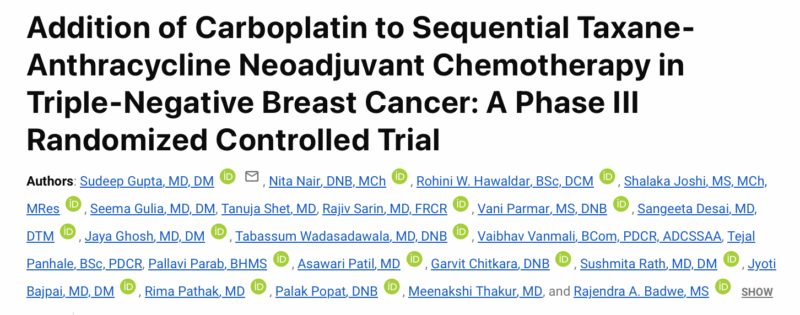Amol Akhade, Senior Consultant at Fortis Hospitals Mumbai, shared a post on LinkedIn about a paper by Sudeep Gupta et al. Published on Journal of Clinical Oncology:
“Platinum Power from India
The team led by Dr. Sudeep Gupta at Tata Memorial Centre has published the long-awaited phase III randomized trial evaluating carboplatin in triple-negative breast cancer (TNBC) — now in JCO 2025.
Study at a Glance Design:
Single-center, randomized phase III (n = 717)
Population: Stage II–III TNBC Arms: Experimental → Weekly Paclitaxel 100 mg/m² + Carboplatin AUC 2 × 8 weeks → Anthracycline + Cyclophosphamide
Control → Same regimen without carboplatin
Primary endpoint: Event-Free Survival (EFS)
Secondary endpoints: Overall Survival (OS), pCR,
Toxicity Median follow-up: 67.6 months
Key Results
Overall (ITT Population):
- 5-yr EFS → 70.7 % vs 64.1 % (HR 0.80; p = 0.081)
- 5-yr OS → 74.4 % vs 66.8 % (HR 0.74; p = 0.029
- pCR → 54.5 % vs 40.3 % (p < 0.001)
Premenopausal Patients: (58 % of cohort)
- 5-yr EFS → 75.0 % vs 59.6 % (HR 0.61; p = 0.003)
- 5-yr OS → 78.2 % vs 64.6 % (HR 0.57; p = 0.002)
Clear, statistically significant improvement in both EFS and OS.
Postmenopausal Patients:
No additional EFS or OS benefit — standard anthracycline-taxane chemotherapy already performs well here
Why the Benefit in Premenopausal TNBC?
Premenopausal TNBC is biologically more ‘active’ – richer in tumor-infiltrating lymphocytes (TILs), more basal-like and HRD-high, and therefore more responsive to DNA-damaging agents like platinum.
In contrast, postmenopausal TNBC often shifts toward luminal-AR, low-proliferation biology with fewer immune cells and intact DNA repair – making it less sensitive to platinum.
In essence, younger TNBCs are immune-rich and genomically unstable; older ones are biologically quieter.
Safety Slightly higher grade ≥ 3 myelosuppression with carboplatin. No difference in non-hematologic toxicities.
90 % of patients completed planned treatment – excellent tolerability.
How Does It Compare with Other Platinum Trials in TNBC?
GeparSixto (Lancet Oncol 2014; Ann Oncol 2018):
Weekly carboplatin improved pCR (53% vs 37%) and showed an EFS trend, but not powered for OS.
CALGB 40603 (JCO 2015; 2022 update):
Added carboplatin ± bevacizumab to weekly paclitaxel → ddAC; increased pCR but no EFS or OS benefit, likely diluted by bevacizumab and dose reductions.
BrighTNess (Lancet Oncol 2018; Ann Oncol 2022):
Phase III trial; carboplatin improved pCR and showed a descriptive EFS advantage, but no statistically tested OS improvement due to hierarchical design limits.
Broader Context
Clinical Implications In settings where immunotherapy is not feasible due to cost or access, a weekly Paclitaxel + Carboplatin → Anthracycline sequence remains a robust, curative option for premenopausal TNBC.
The results also emphasize the need for biology-driven personalization rather than uniform intensification.
A proud moment for Indian oncology and a model for cost-effective, evidence-driven care in LMICs.”
Title: Addition of Carboplatin to Sequential Taxane-Anthracycline Neoadjuvant Chemotherapy in Triple-Negative Breast Cancer: A Phase III Randomized Controlled Trial
Authors: Sudeep Gupta, Nita Nair, Rohini W. Hawaldar, Shalaka Joshi, Seema Gulia, Tanuja Shet, Rajiv Sarin, Vani Parmar, Sangeeta Desai, Jaya Ghosh, Tabassum Wadasadawala, Vaibhav Vanmali, Tejal Panhale, Pallavi Parab, Asawari Patil, Garvit Chitkara, Sushmita Rath, Jyoti Bajpai, Rima Pathak, Palak Popat, Meenakshi Thakur, Rajendra A. Badwe
Read the full article on Journal of Clinical Oncology.

More posts featuring Amol Akhade on OncoDaily.
